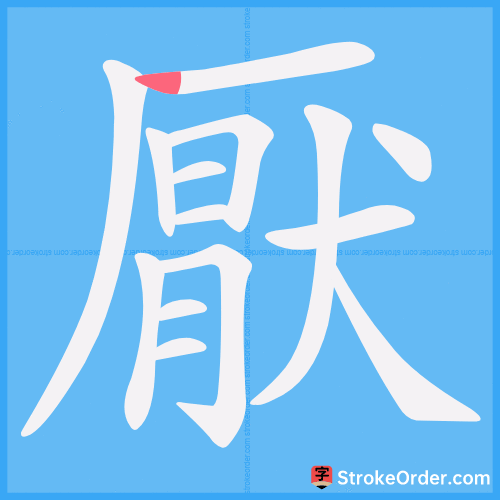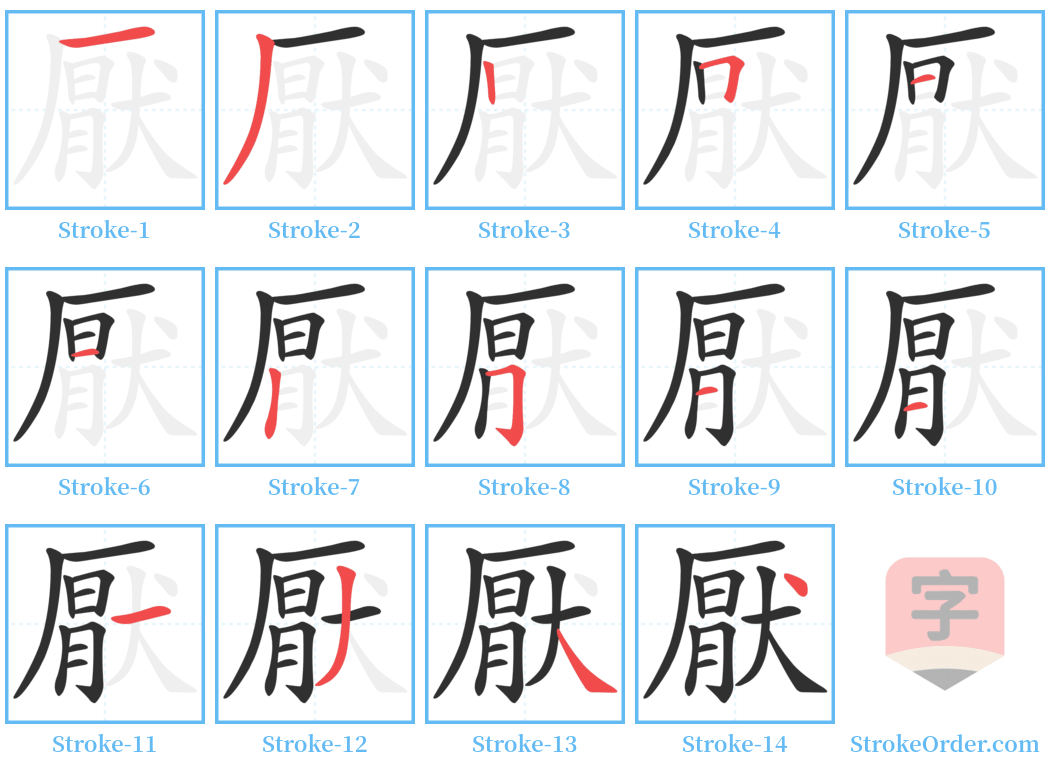厭 Stroke Order
Animated Stroke Order of 厭

Stroke Order Diagrams for 厭

Step-by-Step Handwriting Guide for 厭

Learn to Write Chinese Characters with Video Tutorials
Watch the video of writing the Chinese character "厭", learn the correct stroke order (笔顺) of the character "厭", and master the standard way of writing the character "厭".
Free Printable Handwriting Practice with Stroke Order: 厭
Printable Writing Practice Worksheet of "厭" in Portrait Orientation (Tian Zi Ge)

Printable Writing Practice Worksheet of "厭" in Landscape Orientation (Tian Zi Ge)

Information of 厭
Pinyin
yàn
Radical
厂
Strokes
14 strokes
Usage
★★★
Definition
loathe
厭 yàn
1. Loathe, abhor.
2. Satisfied.
1. 嫌惡,憎惡:厭惡 (wù)。討厭。不厭其詳。學而不厭。
Loathe, abhor: loathing (wù). Dislike. Not tired of details. Learning without weariness.
2. 滿足:貪得無厭。
Satisfied: greedily wanting more.
本义: 吃飽
Origin: To be full.
造字法: 形聲。从廠 (hǎn),猒 (yàn)聲。廠象山崖石穴形。《說文》:「厭,笮也。」意思是「壓」。由「犬、肉、甘」三部分合起來,會意,表示「吃飽」、「滿足」。
Character formation: Phonetic-ideographic. From the radical factory (hǎn) and the sound component (yàn). The radical resembles the shape of a cliff or rock cave. In "Shuowen," it states: "厭, means to press." Combining "犬, 肉, 甘" signifies to be full, to be satisfied.
1. 飽,滿足。後作「饜」 ([En.] be satisfied)
Full, satisfied. Later written as 饜 ([En.] be satisfied).
引:
1. 《論語》:學而不厭,誨人不倦,何有於我哉?
2. 《左傳·僖公三十三年》:不厭。
3. 宋·蘇洵《六國論》:秦之慾無厭。
4. 宋·蘇軾《教戰守》:求之者無厭。
例:
又如: 厭極 (satisfied to the fullest); 厭飫 (to be full; to be sick of food; satisfied); 厭塞 (satisfied); 厭僞 (satisfied with deceits); 厭戀 (to be attached out of satisfaction); 厭副 (satisfied); 厭足 (satisfied).
2. 憎惡; 嫌棄 ([En.] loathe; abhor; detest)
Loathe, dislike ([En.] loathe; abhor; detest).
引:
1. 清·梁啓超《譚嗣同傳》:人常厭事。
2. 惟厭事也。
3. 宋·姜夔《揚州慢》:猶厭言兵。
4. 明·宗臣《報劉一丈書》:無厭其爲迂。
5. 曹禺《雷雨》:這兒我住厭了。
例:
又如: 厭世 (discontent with the world); 厭厭地 (in a dispirited manner); 厭物 (derogatory term for something disliked); 厭鈍 (displeased, dull); 厭色 (a face of annoyance or dissatisfaction); 厭苦 (to be tired of suffering).
3. 另見 yā
For more see yā.
厭 yā
1. 一物壓在另一物上 ([En.] press)
An object pressing on another ([En.] press).
2. 泛指壓制; 抑制 ([En.] restrain)
Broadly refers to restraining ([En.] restrain).
引:
1. 《漢書·翼奉傳》:東厭諸侯之權,西遠羌胡之難。
2. 《漢書·辛慶忌傳》:故賢人立朝,折衝厭難,勝於亡形。
例:
又如: 厭抑 (to suppress).
3. 以迷信的方法,鎮服或驅避可能出現的災禍,或致災禍於人 ([En.] pray for suppressing or driving away)
Using superstitious methods to subdue or ward off potential disasters, or to bring disaster to others ([En.] pray for suppressing or driving away).
引:
1. 《史記·高祖紀》:秦始皇帝常曰:「東南有天子氣」,於是因東遊以厭之。
例:
又如: 厭法 (a magic spell used to subdue opponents).
4. 堵塞 ([En.] block up)
To block up ([En.] block up).
引:
1. 《荀子·修身》:厭其源,開其瀆。
5. 另見 yàn
For more see yàn.
参见「厌厌」条。
Refer to the entry for "厌厌."